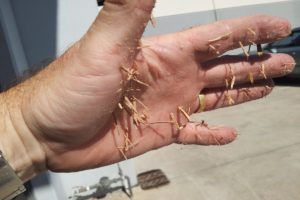The minimum free fall height resulting from all test drops of an instrumented head onto a surface for which an HIC equivalent of 1000 or a G-max value equivalent to 200 is obtained. AS4422 has been updated to include T1 – T2 > 3ms this means that any impact that is less than 3ms in time is not an impact surface.
Impact attenuation requirements
The impact attenuation requirements of surfaces or surfacing materials should be tested by the following means:
Laboratory testing: The critical fall height for each material or combination of materials shall be determined. ( If one playground surfacing system has several different shockpad each system with shockpad needs to be tested as a unique tested system. )
On-site testing : The critical fall height of the surfacing material within the fall zones of equipment or structures shall exceed the free fall height for each item of equipment.
Loose fill materials : Loose fill materials eg bark chips, will deteriorate and be dispersed in use. To allow for this deterioration an additional 50 mm of material described in a test report shall be installed. A minimum depth of 200 mm is required. (Install the original bark at 300mm then when it is down to 200mm get it topped up.)
No splinters are allowed if you squeeze you hand in the product and the sharp wood splinters stick into your hand then it is hard to ask a child to plant there face in the soft material.

Bark chip with splinters.
To get the bark mulch/wood chip tested for CFH send me a small 300mm plastic clip lock bag of material, so I can examine for sharps and the dust in the sample.( to AS 2985 and ISO7708)
( then a 1/3 bulka bag is required to sent and tested in the laboratory.)
AS4685.0 appendix D gives guidance on the type of products that are suitable. NOTE: More detailed information on inhalation hazard is provided in AS 2985 and ISO 7708 Table B1.
Specific requirements for impact attenuation :
Fall heights up to and including 600 mm : surfacing (impact absorbing) may be used without being tested
Fall heights over 600 mm : For playground equipment with a free fall height of greater than 600 mm, surfacing which gives a critical fall height equal to or greater than this height is required to be tested in the fall zone.
Equipment:
Drop system: Free fall use tri-axial accelerometers. Guided fall to use a co-linear uni-axial accelerometer and timing gates for measurement of impact velocity.
Headform: ISO headform as specified in ASNZS 2512.1 with a mass of 4.6 +/- 0.1 kg
Accelerometers and signal processing equipment: Shall conform to channel class 1000 of ISO 6487. AS4422 require the equipment to be calibrated to ISO17025 every two years.
Laboratory products need to be tested by an ISO 17025 calibrated laboratory every three years.
Testing
Loose fill materials : 3 impact drops from the same height are required at each test position.
Non-deformable materials: a minimum of 3 drops required at each of 4 or more positions representative of a typical installation of the material.
Processing: Graphs shall be drawn of Fall Height versus HIC, and Fall Height versus G-max. The critical fall height is determined from the graph using the HIC = 1000, G-max <= 200 or t1 – t2 > 3ms criterion. If the impact is quicker than t1 – t2 > 3ms the material is not an impact material and should not be used as a soft material.